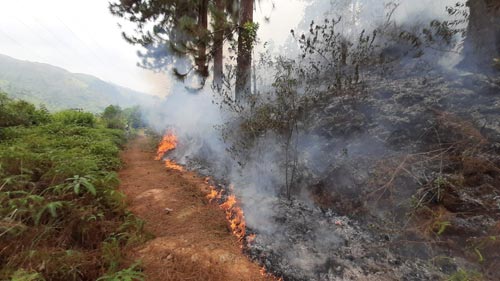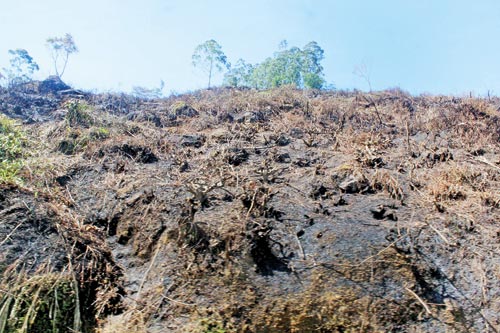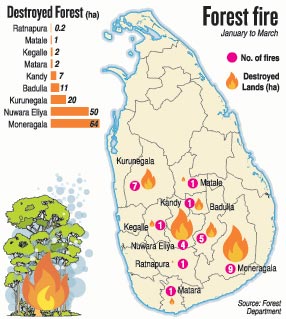News
Wilful forest fires devastate land and wildlife
 Forest fires are on the rise yet again, as dry spells provide an excuse for some locals to set forests alight, while officials plead against such wanton destruction.
Forest fires are on the rise yet again, as dry spells provide an excuse for some locals to set forests alight, while officials plead against such wanton destruction.
Contrary to popular belief that burning forests is beneficial, blackening acres of greenery is a common occurrence every year. No sooner the dry spells take over, reports of blazing forests with extensive acres of destroyed land begin to increase in number.
“We can’t call these wildfires as these are fires lit by people intentionally, or very occasionally, an accidental fire may go out of control. A wildfire is something that happens spontaneously,” said environmental lawyer Jagath Gunawardana.
 Fires are started for many reasons. Among them, hunters seeking game, owners of cattle who burn the land for new grass, and land grabbers.
Fires are started for many reasons. Among them, hunters seeking game, owners of cattle who burn the land for new grass, and land grabbers.
Reports revealed that a certain group of locals is engaged in the act as a habit, while others committed arson merely for “fun” as they “enjoy” watching the flames.
“The central hills have the highest biological diversity and a high mix of endemism followed by the Kegalle and Ratnapura districts,” Mr. Gunawardena said, “When you look at the pattern of forest fires in Sri Lanka, they occur within the dry month. And almost all the time, the dry spells are followed by a bout of heavy rain.”
He further explained that a period of heavy rain is dangerous to the exposed soil damaged by the forest fire. The rains cause erosion and landslides if the fire occurs near a slope.
One consequence of fires is that invasive alien species such as Guinea Grass grow and take over.

Jagath Gunawardana
“You only need a box of matches to light an entire forest,” said Pradeep Kodippili, director and media spokesperson of the Disaster Management Center (DMC). “It will drop the air quality completely, and the wildlife will be totally destroyed along with the eggs of important species, and water resources will be contaminated. People need to understand the gravity of these fires and their perceptions need to change. Otherwise, we will face a huge disaster situation in the future.”
Ravindra Kumara, the deputy director of the Disaster Management Center in the Monaragala District Secretariat, updated the Sunday Times on the current situation as most fires were reported from the area. “All hilly areas have dried up due to the dry season, and there were about 12 reported fires so far,” he said.
Although there is no direct threat to human lives, the drying of streams would in the end badly affect people.
“The DMC has committees all around the province,” he said, speaking on the standard process, from reporting to dousing the fires. The secretariat expects a slight decrease in forest fires as light showers have resumed in the area.
Conservator General of Forests Nishantha Edirisinghe said that 30 fires had been reported so far (see graphic). “Last year, there were 148 fire events destroying 1228 hectares.’’
So far, the highest number of forest fires has been reported from Monaragala, where nine fires have wrecked 64 hectares. The second highest land damage was reported from Nuwara

Pradeep Kodippili
Eliya, where 50 hectares of land had been destroyed by four fires. In Kurunegala there had been seven fires that destroyed 20 hectares.
March 25-31 marks a significant week as it has been declared ‘Forest fire controlling week’.
“During this week, we will identify the places which are prone to fires, and educate the public,” Mr. Edirisinghe said. ‘Fire belts’ (10 metres of bare land) will be created in the identified areas. The Forest Department has planned to plant one million trees this year outside of forests such as home and common gardens, private lands, religious places as well as on roadsides. Plants will be given free.
Convener of the biodiversity and research circle Supun Lahiru Prakash said that due to the fires, the forest cover opens up, eroding the land, which then affects the farming community and hydro power generation as the water gets contaminated, ultimately resulting in a change in climate and local weather conditions.
 Environmentalist Sajeewa Chamikara of the Movement for Land and Agriculture Reforms, said: “There is a rapid decline of the animal population that lays eggs especially during the dry season due to the fires that destroy micro habitats. They may become extinct.’’
Environmentalist Sajeewa Chamikara of the Movement for Land and Agriculture Reforms, said: “There is a rapid decline of the animal population that lays eggs especially during the dry season due to the fires that destroy micro habitats. They may become extinct.’’
In a study, Mr. Chamikara says he uncovered a rather unusual reason for a forest fire. “In a dispute between a husband and wife, the wife fled to the forest seeking solace to escape her abusive, drunken husband. The husband had set the forest ablaze in order to bring the wife back,” he said highlighting frivolous actions of some locals.
Apart from fire belts, Mr. Chamikara suggests that ‘green belts’ consist of plants that can bear heat to replace the bare land.
Interestingly, officials of the Department of Wildlife and Conservation (DWC) said that there was no such threat to wildlife based on the fires reported so far.
Carrying out awareness campaigns, distributing leaflets, billboards and public announcements are among the ways with which the Forest Department and the DMC reach out to people.
The Fauna and Flora Protection Ordinance under the purview of the Wildlife Department, and the Forest Conservation Ordinance under the purview of the Forest Department determine the fines for offenders by court order. However, suspects flee the scene and are not easily caught.
Under the Forest Conservation Act, igniting a fire for any given reason is an offence. The ultimate verdict provided by a court for igniting a forest reserve (an area of forest set aside by the Government as a wilderness) varies from Rs 10,000 to Rs 100,000, or a five-year jail term, or both. The fine for igniting a conservation forest (forests preserved for future generations) varies between Rs 20,000 and Rs 200,000, or a seven-year imprisonment, or both.
All authorities contacted by the Sunday Times urge people to not ignite forest fires as the ultimate cost is borne by wildlife species as well as the locals themselves.
The best way to say that you found the home of your dreams is by finding it on Hitad.lk. We have listings for apartments for sale or rent in Sri Lanka, no matter what locale you're looking for! Whether you live in Colombo, Galle, Kandy, Matara, Jaffna and more - we've got them all!

